DISTINGUISHED ACHIEVEMENT AWARD WINNERS
SCVP is proud to honor these pioneers and leaders of our field.
2024 - E. Rene Rodriguez
Dr. E Rene Rodriguez’s journey into cardiovascular pathology began during his time in medical school, where a stint as a visiting student and later an assistant physician in Anatomic Pathology at the National Institute of Cardiology in Mexico City ignited his passion for the field. This early experience served as the foundation for his future endeavors after he obtained his medical degree from the Universidad Autónoma Metropolitana – Xochimilco in January 1982.
In August 1982, Rene embarked on a four-year fellowship at the Ultrastructure Section, Pathology Branch of the National Heart, Lung, and Blood Institute in Bethesda, MD, under the mentorship of leading experts in the field of cardiovascular pathology. Rene then transitioned into Anatomic and Clinical Pathology residency training at The George Washington University Medical Center in Washington, DC.
In 1990, Rene assumed the directorship of the Cardiovascular Pathology Unit at Rush Heart Institute in Chicago, IL. During his tenure at Rush University, he also undertook the responsibility of directing Autopsy Pathology services. In 2000, Rene took on the role of Director of Clinical Services in Cardiovascular Pathology at The Johns Hopkins Hospital in Baltimore, MD. His leadership and contributions solidified his reputation as a respected figure in cardiovascular pathology.
Since 2004, Rene has served as the Director of Cardiovascular Pathology and Director of Autopsy Pathology at The Cleveland Clinic in Cleveland, OH. In addition to his extensive professional experience, he is a Professor of Pathology at the Cleveland Clinic College of Medicine of Case Western Reserve University. His outstanding contributions to the education of cardiovascular medicine fellows was duly recognized with a teaching award in 2015.
His academic impact include more than 200 manuscripts and book chapters covering his multidimensional expertise in the field from basic science to clinical cardiology. He played a pivotal role in revising the criteria for antibody-mediated rejection in cardiac transplantation during his tenure as Chair of heart sessions at the Banff Conference in Allograft Pathology and later of the Pathology Council of the International Society for Heart and Lung Transplantation.
Throughout his career, Rene has been dedicated to advancing the field of cardiovascular pathology through his clinical expertise, leadership, and scholarly contributions. His commitment to nurturing the next generation of cardiovascular pathologists truly exemplifies the spirit of the 2024 SCVP Distinguished Achievement Award.
2023 - John Veinot
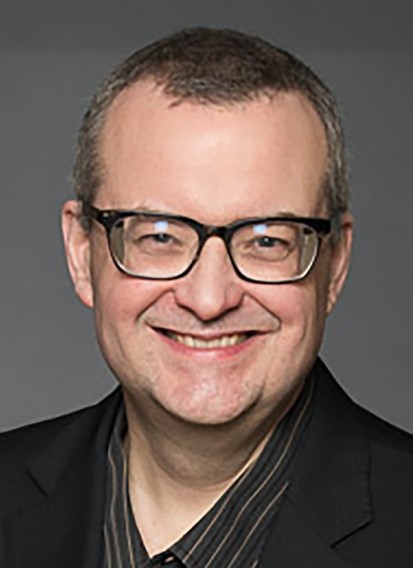 John P. Veinot
John P. Veinot
Dr. John Veinot is an exemplary physician, educator, investigator, and administrator who has made significant contributions to the field of cardiovascular pathology and to the SCVP over many years.
John received his M.D. from Dalhousie University in Halifax, N.S., in 1988, followed by residency in Anatomical Pathology at Queen’s University in Kingston, ON, and Cardiovascular Pathology fellowship at the Mayo Clinic in Rochester, MN. In 1994, he joined The Ottawa Hospital and the University of Ottawa, where he remained until his recent retirement from anatomical pathology practice.
Along the way, he became Full Professor in the Faculty of Medicine and served many administrative roles, including eleven years as the Chair of the Department of Pathology and Laboratory Medicine at the University of Ottawa, Head of the Departments of Pathology and Laboratory Medicine at The Ottawa Hospital and the Children’s Hospital of Eastern Ontario, and Chief of Medical Staff for the Eastern Ontario Regional Laboratory Association, where he emphasized the need for quality and patient-centered care.
His passion for teaching led to several teaching awards, including the uOttawa Excellence in Education Prize, the Faculty of Medicine Award for Excellence in Medical Education, the Pathology and Laboratory Medicine Best Teacher Award (twice), and the Faculty of Medicine Educator Award for Communicator Competence. He recognized the importance of teaching pathology beyond medicine and is proud of the achievements of those he has mentored.
As a Clinical Investigator at the Ottawa Hospital Research Institute, John made numerous research contributions in cardiovascular pathology, running the gamut from basic science to clinicopathologic correlations, leading to more than 200 manuscripts, multiple book chapters, and a book on echocardiography-pathology correlations.
John has been an integral part of the SCVP, serving on multiple committees and as its past president, and was instrumental in the publication of multiple consensus documents. He promoted the use of new and different modes of education, stressed the importance of diversity, and fostered collaboration with the AECVP – these efforts expanded the reach of our Society.
Most of all, John has always been approachable, dependable, and willing to help promote the discipline of cardiovascular pathology. We are proud to honor him with the 2023 SCVP Distinguished Achievement Award.
2022 - Richard Mitchell
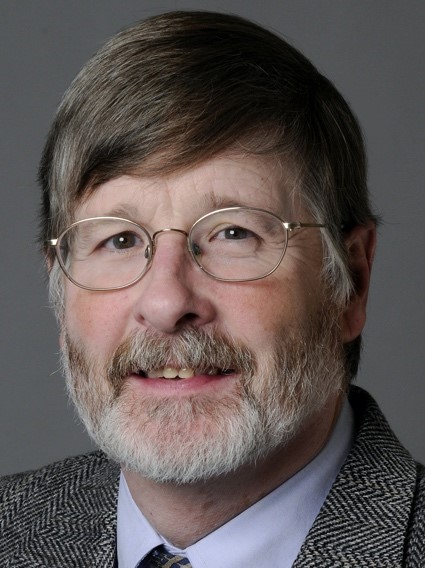 Richard N. Mitchell
Richard N. Mitchell
Dr. Rick Mitchell is an exemplary physician-scientist-educator who has made broad and impactful contributions to the field of cardiovascular pathology over many years.
Rick received his Ph.D. in Cell Biology/Immunology from The Rockefeller University in 1980 and his M.D. from Harvard Medical School in 1984. Following an internship in internal medicine at the Beth Israel Deaconess Medical Center, he completed pathology residency, cardiac pathology fellowship, and post-doctoral fellowship at the Brigham and Women’s Hospital. He joined Harvard Medical School and BWH as Assistant Professor in 1992 and ascended the academic ranks, culminating in his appointment as the Lawrence J. Henderson Professor of Pathology and Health Sciences and Technology in 2011.
Rick is a leading expert in the discipline and practice of cardiovascular pathology. He serves as a Senior Pathologist in the cardiac pathology and autopsy divisions in the Department of Pathology at BWH. He has made numerous research contributions in work conducted at the interface of immunology and vascular cell biology, including the mechanisms underlying acute and chronic rejection following heart transplantation, the role of specific cytokines and chemokine pathways in allograft vasculopathy, the source of recruited intimal smooth muscle cells in atherosclerosis, the nature of inflammatory cell populations involved in the pathogenesis of abdominal aortic aneurysm, and the immunology of cardiac valve disease. Moreover, he has been and continues to be a highly valued collaborator in studies focused on stem cell biology and the cardiovascular system, amyloidosis, gender differences in gene expression profiles, cardiac electrophysiology, and AI applications to cardiovascular pathology.
Rick also possesses a genuine, strong dedication to and aptitude for teaching and educational leadership, and serves as an important role model to medical students, pathology residents, and faculty colleagues. His teaching of residents on the autopsy and cardiac pathology services at BWH is well known and admired. He is passionate about conveying the scientific basis of medicine in both the pre-clinical and clinical segments of the undergraduate medical curriculum, and has been Director of the HST-030 Human Pathology course for over two decades (notably, this course is ranked by the HST MD students as the most effective and enjoyable course in their entire four-year curriculum). He also actively teaches or has taught in other HST courses in Cardiovascular Pathophysiology, Immunology, and Biomaterials and Tissue Engineering, as well as in the Harvard Medical School New Integrated Curriculum’s Immunology, Microbiology and Pathology course. Rick has demonstrated long-term and highly effective leadership as Associate Director of the HST Division for over two decades, during which he has directly mentored over 500 students. His teaching commitment and prowess have been recognized with seven teaching awards at Harvard Medical School and, nationally, he has received the Robbins Distinguished Educator Award from the American Society of Investigative Pathology (ASIP) and the Michele Raible Distinguished Teaching Award in Undergraduate Medical Education from the Association of Pathology Chairs.
Rick’s educational contributions have had a wide international reach. For many years he has been active in writing and editing the most widely used textbooks that educate most medical students around the world, including Robbins Basic Pathology, Robbins and Cotran Pathologic Basis of Disease, the Pocket Companion to Robbins and Cotran Pathologic Basis of Disease, and Biomaterials Science: An Introduction to Materials in Medicine. He also co-authored Robbins and Cotran Pathology Flash Cards, with an innovative design format, and co-edited a novel online book, Pathobiology of Human Disease.
Rick has given extraordinary service to the SCVP and other leading organizations in pathology. He is a past-Programming Chair and a past-President of the SCVP. He is also past-Chair of the Education Programming Committee and past-President of the American Society for Investigative Pathology, and developed and directed the annual ASIP Summer Academy, during which he taught fundamentals of acute and chronic inflammation and wound healing to graduate students, fellows, junior and senior faculty, and scientists in industry. He is one of the original organizers of the annual ASIP stand-alone meeting Pathobiology for Investigators, Students, and Academicians (PISA). Rick is also a Senior Associate Editor of the American Journal of Pathology, and Associate Editor of both Laboratory Investigation and SCVP’s official journal, Cardiovascular Pathology.
2021 - Not given
2020 - Allen Burke
 Allen P. Burke
Allen P. Burke
Dr. Burke is a current member of the Society of Cardiovascular Pathology and an Editorial Board Member of the Society’s Journal since 2002. He has made substantial contributions to the field in the peer-reviewed literature as well as innumerable lectures and workshops for more than 25 years.
His body of work includes more than 260 peer-reviewed journal article publications including a disproportionate number of first and last author publications, 6 complete books, and more than 70 book chapters. He was the senior editor of the 2015 WHO Classification of Heart Tumors.
He has been involved in teaching a large number of medical students, pathology residents, pathologist’s assistants, clinicians and scientists during the past decades, several of whom are active members of the Society and the cardiology community, at-large.
Moreover, his work has been recognized by others in the field, receiving over 21,000 citations, making him among the most cited pathologists in the world.
2019 - Gayle Winters
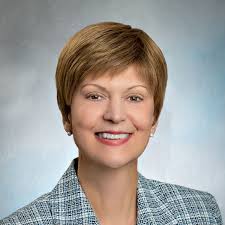 Gayle Winters
Gayle Winters
Gayle Winters is a distinguished member of the global cardiovascular pathology and transplantation communities. She received her BS in Biology (with Distinction) from Purdue University, and her MD in 1979 from the Loyola Stritch School of Medicine, followed by a year of general surgery residency, residency in anatomic and clinical pathology, and fellowship in surgical pathology at Loyola University Medical Center. After joining the Loyola faculty and rising to Associate Professor of Pathology, she was recruited to the Brigham and Women’s Hospital (BWH) in 1992, where she is Senior Pathologist and Associate Professor of Pathology at Harvard Medical School.
Dr. Winters has a national and international reputation as a heart transplant pathologist and serves or has served on the Editorial Boards of Circulation, Cardiovascular Pathology, Journal of Heart and Lung Transplantation, and Advances in Anatomic Pathology. Within the Society for Cardiovascular Pathology, Dr. Winters has held important leadership positions as Cor Notes Editor, Secretary, Acting Treasurer, Vice-Present/President Elect, and President.
Among sentinel contributions to her field, Dr. Winters was a member of the working group and co-author on the original 1990 grading system for cardiac transplant biopsies, its revision in 2005, and the grading system for antibody-mediated rejection in 2011. These grading schemas are considered the foundational guidance for all of heart transplant practice to the current time. Her work demonstrated the lack of progression of untreated Grade 2 rejection, and was instrumental in prompting the revision of the grading system in 2005. Other important work within the area of cardiac transplantation includes defining perioperative ischemic injury on post-transplant endomyocardial biopsies, studying the pathologic composition and clinical significance of Quilty effect, and defining the composition of allograft coronary disease and the use of myocyte vacuolization on post-transplant endomyocardial biopsies as a predictor of allograft coronary disease.
Dr. Winters has been actively involved in resident and medical student education throughout her career. In fact, she is a major educational leader in her home institution. She was the Director of the BWH Autopsy Service for over 20 years, Director of the BWH Residency Program in Pathology from 2001-2015, and served as Director of the BWH Harvard Medical School elective clerkship in Pathology. She has taught at Harvard Medical School in the Human Pathology and Cardiovascular Pathophysiology courses. Of perhaps the greatest significance in terms of the continued expertise in cardiovascular pathology as a discipline, Dr. Winters and her colleagues at BWH have trained 12 Cardiovascular Pathology Fellows. Of these Fellows, 7 have pursued a career in cardiovascular pathology and are current members of the Society for Cardiovascular Pathology. At the national level, she has been an active member of the Program Directors for Pathology (PRODS), and served as Member-at-Large of PRODS Council, Co-Chair of the PRODS Outcomes Committee, Secretary-Elect, Secretary, Chair-Elect, and was elected Chair in 2014-15. She received the Graduate Medical Education Distinguished Teaching Award from the Association of Pathology Chairs in 2016.
In summary, Dr Winters exemplifies the professional skills and leadership qualities that the SCVP Distinguished Achievement Award was established to honor. She has been and is a recognized scholar in her field, she is widely known as an educator in cardiovascular and transplant pathology, and she has served in many leadership roles for the SCVP and other related organizations. She certainly is an expert in the field of cardiovascular pathology.
Finally, Dr Winters is an absolutely lovely human being. She is a person of great character and great courage.
2018 - Kricket and Jon Seidman
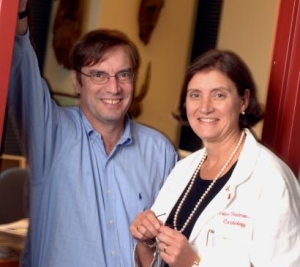 Kricket and Jon Seidman
Kricket and Jon Seidman
Dr. Kricket Seidman is the T.W. Smith Professor of Medicine & Genetics in the Department of Genetics at Harvard Medical School, is a Howard Hughes Investigator, and is a cardiologist at Brigham and Women’s Hospital, where she is also the Director of the Cardiovascular Genetics Center. She has received the American Heart Association Basic Science Prize, the American Society for Clinical Investigation Award, the Glorney-Raisbeck Prize, and the Schottenstein Prize.
Dr. Jon Seidman is the Bugher Foundation Professor of Cardiovascular Genetics, and a former Howard Hughes Investigator. Together they co-direct a lab in cardiovascular genetics that focuses on understanding the causes of hereditary heart disease and have been jointly recognized as recipients of the Pasarow Foundation Award in Cardiovascular Research, the Bristol-Myers Squibb Award for Distinguished Achievement in Cardiovascular Research, and the Institut de France Fondation Lefoulon-Delalande Grand Prix for Science Award.
The Seidmans numerous discoveries have elucidated the role of sarcomeric and other proteins in hypertrophic cardiomyopathy but have also contributed substantially to understanding the role of several genes (such as lamin A/C, eyes-absent-4, phospholamban, myosin heavy chain, troponin T, and titin) in dilated cardiomyopathy. Their recent work in cardiac transcription factor mutations in congenital heart defects has also been groundbreaking. These efforts have enabled improvements in precision diagnostics and therapeutic interventions for these conditions.
By developing and applying advanced sequencing strategies and correlating cardiomyopathy mutations with functional myocyte biology, the Cardiovascular Genetics Center labs have uncovered new and important insights into pathogenic pathways. Using these insights, they (and others) can now target linchpin molecules to develop novel therapeutic strategies to arrest the progression of cardiomyopathies. This is taking us beyond gross and microscopic pathology into the very “heart” of the pathologies of myocardial disease.
2017 - John (Jay) T. Fallon III
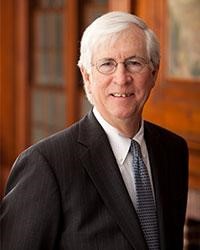 John (Jay) T. Fallon III
John (Jay) T. Fallon III
John T. Fallon III MD, PhD received his BA from Providence College and his MD and PhD from Albany Medical College. Even during medical school he was interested in cardiovascular pathology, as his PhD thesis was entitled Hemodynamics and atherosclerosis: Endothelial damage and ultrasonic arterial lesions. Dr. Fallon then went on to pursue pathology training at Massachusetts General Hospital, Harvard Medical School. He was recipient of an NIH public health service training grant to continue fellowship training Massachusetts General Hospital, Harvard Medical School. He remained at Massachusetts General Hospital as an Assistant then Associate Professor of Pathology both at Harvard Medical School and Massachusetts Institute of Technology, Division of Health Sciences and Technology. Dr. Fallon joined Mount Sinai School of Medicine in 1994 as a Professor of Pathology. He became Chairman and Professor of Pathology at New York Medical College in 2009.
Dr. Fallon has a strong history of research with over 290 original reports, overwhelmingly related to cardiovascular pathology and his major research interests in pathophysiology of ischemic heart disease, experimental vascular injury, and the immunopathology of human myocarditis and allograft rejection. His research in the field of atherosclerosis has helped to delineate the pathogenesis of thrombogenicity of atherosclerotic plaques, the role of inflammation in plaque rupture, and the mechanisms of intimal hyperplasia and restenosis after vascular interventions, to name but a few areas of his investigations. Dr. Fallon is a former member of the NIH Scientific Review Group of the Cardiovascular and Renal Study Section and he has also been the PI on NIH SCOR and training grants, most recently PI for NIH Thrombosis SCOR – Pathology Core and Co-Investigator in vulnerable Plaque Studies. He also served as a member of the NIH Myocarditis Study Group.
Dr. Fallon is a Founding- Member, Past- President, Past Awards Chairman and Past Councilor of the Society for Cardiovascular Pathology and is on the editorial board of Cardiovascular Pathology.
2016 - Jeffrey E. Saffitz
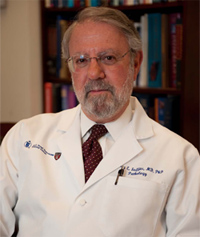 Jeffrey E. Saffitz
Jeffrey E. Saffitz
Dr. Saffitz received his M.D. and Ph.D. degrees from Case Western Reserve University in 1978. He completed both a Residency in Anatomic Pathology and a Cardiovascular Research Fellowship at Washington University School of Medicine in St. Louis. From 1982-1983 he was Visiting Fellow in Cardiac Pathology at the National Heart, Lung and Blood Institute with Dr. William Roberts. He then returned to Washington University on the faculty in the Departments of Pathology and Medicine (Cardiovascular Division) and rose through the ranks to become Paul and Ellen Lacy Professor of Pathology in 1999. In 2005 he was recruited to his current position in Boston.
Dr. Saffitz is a leading basic and translational investigator in the area of sudden cardiac death, arrhythmia mechanisms in arrhythmogenic cardiomyopathies, and cardiac myocyte electrical communication. His several decades of independent, federally funded research have yielded over 260 original contributions to the literature. His research has elucidated molecular and structural determinants of normal and abnormal intercellular coupling and defined the role of altered expression of connexins (gap junction channel proteins) and remodeling of gap junctions in the pathogenesis of lethal ventricular arrhythmias. He has characterized the molecular pathology of human cardiomyopathies with the clinical phenotypes of arrhythmogenic right ventricular cardiomyopathy (ARVC), such as Naxos disease, Carvajal syndrome, ARVC Type 8 and plakophilin-related cardiomyopathies, which are caused by mutations in genes encoding proteins at cell-cell mechanical junctions. He described a new endomyocardial biopsy test that looks for abnormally low levels of plakoglobin, an essential component of cardiac myocyte junctions, and identified low levels of plakoglobin as a possible marker for ARVC (NEJM, 2009).
Dr. Saffitz has served as President of the Society for Cardiovascular Pathology, and in leadership roles in the American Heart Association and the Heart Rhythm Society. He has been a member of the Editorial Boards of 10 journals of pathology and cardiovascular medicine and is currently an Associate Editor of Cardiovascular Pathology, Circulation, and the American Journal of Pathology, and he is on the Editorial Board of the American Journal of Cardiology. He authored the chapter on The Heart in the 6th and several prior editions of Rubin’s Pathology. He is also a national leader in genomic pathology in personalized medicine, and has spearheaded efforts to use next generation sequencing and other high-throughput technologies in routine clinical laboratory diagnostics. He is an accomplished teacher and academic leader, and a prototypical role-model for the cardiovascular pathologist-scientist.
2015 - Michael C. Fishbein
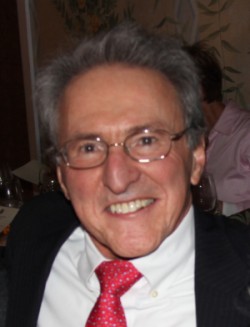 Michael C. Fishbein
Michael C. Fishbein
Dr. Michael Fishbein was born May 25, 1946 in Brussels, to holocaust survivors, who with the help of the Belgian people, survived in hiding in the Belgian countryside for all of WWII. In 1949, the family emigrated to Chicago where Michael’s mother had relatives. When Michael was 12, and his father was 51, his father had his first myocardial infarction. From then on, cardiovascular disease, in one way or another, has played a major role in Michael’s life.
With the help of State of Illinois Scholarships, Michael received his undergraduate and medical school education at the University of Illinois. In medical school, his teacher of congenital heart disease was Dr. Maurice Lev. Michael used one medical school elective to go to the Bispebjerg Hospital in Copenhagen where he participated in a busy autopsy service, and one elective in cardiology at the Mayo Clinic where he had the opportunity to spend time with Dr. Jack Titus on the autopsy service. In part, to escape Chicago winters, he did an internship and residency in pathology at UCLA/Harbor General Hospital (HGH) in Torrance, CA. Because he had an interest in cardiovascular pathology not shared by any of the faculty, Michael inherited most cardiac autopsies and collaborative research projects with the active adult and pediatric cardiologists at HGH. These individuals were very enthusiastic and supportive and urged him to get additional training. Michael was fortunate to be able to secure an elective with Dr. William C. Roberts at the NIH. While at the NIH, he was again fortunate to know and work with outstanding individuals in the field of cardiovascular pathology, namely, Dr. Victor Ferrans, Dr. Max Buja, Dr. Bernadine Bulkley/Healy, and Dr. Barry Maron. He also spent time with Dr. Hugh McAllister at the AFIP where he reviewed the vast collection of congenital hearts, and an elephant’s heart as well.
In addition to being a great teacher, mentor, and friend, Dr. Roberts, through his association with Dr. Eugene Braunwald, was instrumental in recruiting Michael to the then Peter Bent Brigham Hospital. In fact, he was the first appointee of the new Pathology Chairman, Dr. Ramzi Cotran, who took a big chance hiring Michael since he was straight out of residency, very inexperienced, and had not even taken pathology board exams when appointed. After 3 exciting, productive years at the Brigham, and the blizzard of ’77, Michael and his family returned to Los Angeles. He spent 19 very productive years at Cedars-Sinai Medical Center where he was a general anatomic pathologist with a subspecialty interest in cardiovascular pathology. While challenging, practising general pathology exposed him to the full gamut of human disease and a wide array of tools in pathology, such as EM, histochemistry, and immunohistochemistry, that have played a major role in his study of cardiovascular diseases.
In 1997, Michael had the opportunity to move to UCLA, where the anatomic pathology service was more subspecialized. The greater subspecialization, and funding from the Piansky Endowment he received, allowed him more opportunities to pursue research interests in heart disease. From the individuals named above, and brilliant and generous collaborators that are too numerous to name, Michael had exceptional exposure to giants in cardiovascular disease. In his opinion, good fortune, and the generosity of time and effort on the part of his mentors, allowed him to have a fulfilling career in medicine and cardiovascular pathology particularly. Working hard also helped.
Of course, none of his “success” would have been possible without the help of family: devoted parents who sacrificed whatever necessary so he could be educated; his loving and supportive wife of 40 years, Astrid, who took care of most matters while Michael was busy with his career; and two wonderful and accomplished now-grown and married children, Danielle and Gregory, who have been a source of great pleasure and pride. While no one knows what the future holds, Michael’s short-term plans are to continue his current activities at UCLA on a part-time basis, and to spend his “free-time” with his new granddaughter, Maxine, as well as to improve his golf game.
2014 - Jagdish Butany
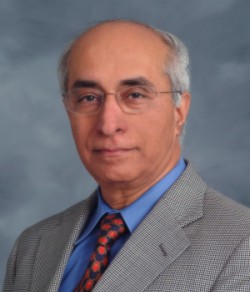 Jagdish Butany
Jagdish Butany
Jagdish Butany is Professor in the Department of Laboratory Medicine and Pathobiology at the University of Toronto, Canada and Director of the Division of Pathology in the Department. He is a Staff Cardiovascular Pathologist at the University Health Network (Toronto General Hospital Site), and Director of Autopsy Services. Dr. Butany works in an interdisciplinary setting with colleagues from related specialities and other health professions. Dr. Butany’s investigative work has primarily been based on clinical investigations and outcomes and collaboration with clinical colleagues in basic and applied research. His major interest has been prosthetic heart valves, an interest nurtured by contact with (late) Dr. Victor Ferrans, and with Dr. Malcolm Silver and Dr. Frederick Schoen.
He trained in India (MBBS), at the Kasturba Medical College in Mysore (Manipal and Mangalore) and had his Post-Graduate training at the All India Institute of Medical Sciences, New Delhi. Dr. Butany moved to Toronto in 1975 and started his pathology training at the University of Toronto (U of T), which he completed in 1979. Since then, he has worked at the Toronto General Hospital (now University Health Network) and the University of Toronto, starting as a Lecturer in 1980, with a break of one year when he was a Fellow at the NIH (National Heart Lung and Blood Institute) at Bethesda, Maryland with (late) Dr. Victor J. Ferrans. During this time, he had the pleasure of working with/meeting a number of pathologists who were fellows there, and Dr. William C. Roberts, then head of the Pathology branch. On his return from the NIH, Dr. Butany joined the Pathology Department of the Women’s College Hospital and six months later started at the Toronto General Hospital as a cardiovascular pathologist. He has worked on several committees at the University, at the Toronto General Hospital, and in the Pathology Department.
Dr. Butany has been involved in teaching at the undergraduate and post-graduate levels, including medical students, pathology residents, cardiology residents and cardiac surgery residents and fellows. He has mentored and taught cardiovascular pathology to numerous students from their second year at university onwards as they went on to become medical students, residents and staff members in diverse disciplines. He is actively involved in undergraduate and graduate teaching at the U of T School of Pharmacy with a focus on cardiovascular pathology. For several years he participated in teaching at the Occupational Therapy/Physiotherapy and nursing schools. One of the interesting aspects of his teaching is the hands on approach to cardiovascular pathology, based significantly on the use of archived cardiac specimens. He has been part of the Laboratory Medicine and Pathobiology Specialist program since its inception, teaching two courses, one on Cardiovascular Pathology and the other on Neoplasms to undergraduate students, using a mix of didactic and “hands on” teaching. These courses have been very well received since their inception. He has been honored by the Toronto General Hospital, the Department of Laboratory Medicine and Pathobiology (University of Toronto) with several teaching awards and by the Faculty of Medicine, University of Toronto with the Aiken’s Award for Individual Undergraduate Medical Student Teaching (1995) and the Colin Wolfe Award for Commitment to Continuing Medical Education (2012).
Dr. Butany has had an abiding interest in Continuing Professional Development for pathologists and was involved with the Royal College of Physicians and Surgeons of Canada, in the setting up of its Maintenance of Certification Program (MOCOMP). He has been involved in continuing medical education programs for many years, and has organized and spoken at two courses on cardiovascular pathology in the late 1980s (in Toronto), courses at the USCAP and at the CAP. He is involved in teaching at courses in India, as well as in other countries. Since its inception, Dr. Butany has been involved in the CME activities of the Association of Indian Pathologists in North America (AIPNA) and often participates in their annual programs in India. He was their Keynote speaker at Vancouver in 2012 and delivered the named Oration (the Nagalotimath Oration) at the Annual CME program at Pondicherry, India, in January of 2013.
Professor Butany played a significant role as the pathologist involved with the SARS pandemic in Toronto (2003). His work on prosthetic mechanical valves was critical in the recall/ taking off the market, of one bileaflet valve (January 2000). He has over 280 peer reviewed publications which cover the gamut of cardiovascular disease with an emphasis on prosthetic heart valves and other cardiovascular devices. Dr. Butany’s publications include many other publications as well as authorship of book chapters and participation as an Editor of other books.
Dr. Butany has been President of the Canadian Association of Pathologists (2006 – 2009), and before that, the Chair of their CME Committee, responsible for organising the educational courses (Short courses) offered at the annual meeting (nine years). Dr. Butany has been honored by the Canadian Association of Pathologists with their Distinguished Service Award (July 2012).
Dr. Butany is a founding member of the Society for Cardiovascular Pathology and has participated in its growth to its present stature as the pre-eminent Society for Cardiovascular Pathologists. He was the President of the Society for Cardiovascular Pathology (2007 – 2009). Dr. Butany has been Co-Editor-in-Chief of Cardiovascular Pathology (with Dr. Avrum Gotlieb), the official journal of the Society of Cardiovascular Pathology and continues to serve on its Editorial Board. Dr. Butany is a member of the Editorial Board of several other journals.
On a more personal note, his personal achievements have made Jagdish realise how blessed and fortunate he has been in his career in Canada and in the colleagues he has worked with. From this has come a deep sense of obligation and the desire to “give back.” He is currently the Secretary-Treasurer of the World Association of Societies of Pathology and Laboratory Medicine (2009 – ) and a member of the Board of the World Pathology Foundation (2009 – ). The primary focus of both of these organisations (WASPaLM and WPF) is improving the quality of pathology and laboratory services worldwide and in helping countries-in-need improve their pathology and laboratory medicine services. Their approach is multifaceted, one facet being the organisation of CME programs for “countries-in-need”. Dr. Butany serves as a Director on the Board of Directors of The Scarborough Hospital (2008- ), the second largest Community/Academic Hospital in the country. Dr. Butany is a member of the Board of Trustees of his community’s Temple and participates actively in the management of the Temple.
Jagdish has had the love and companionship of his charming wife, Vidya Butany (a practising psychiatrist), for over four decades and the pleasure of being involved in the growth of their daughter Indrani, and now their grandchildren Neveah and Riaan and son-in-law Dirk. Amongst the things in his career that Jagdish has found most satisfying is the opportunity to work with his colleagues at the TGH, in the SCVP and his Co-Editor of CVP, Prof (Dr) Avrum Gotlieb.
2013 - Michael A. Gimbrone
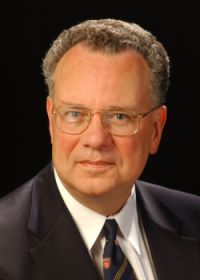
Michael Gimbrone
Introductory remarks of Dr. Fredrick J. Schoen
I am so pleased that Michael A. Gimbrone, Jr. is receiving the 2013 Society for Cardiovascular Pathology Distinguished Lifetime Achievement Award. As a long-term colleague and collaborator, I am delighted to introduce him for this lecture. Dr. Gimbrone is a pioneer and leading investigator in vascular biology, who is widely recognized for his immense contributions to the initiation and scientific and conceptual development of the discipline. Moreover, and importantly, he has shown immense leadership throughout his career in fostering a broad multidisciplinary academic environment in our department locally and far beyond, in which the highest academic standards converge with highly talented young people and key opportunities to promote career and personal success.
Dr. Gimbrone received his A.B. degree from Cornell University and his M.D. degree from Harvard Medical School in 1970. During his medical studies he pursued research in the Department of Anatomy at Harvard Medical School, learning ultrastructural anatomy and cell biology with Donald Fawcett. After completing an Internship at the Massachusetts General Hospital, Boston, and a Research Fellowship at the Children’s Hospital Medical Center, Boston, with Dr. Judah Folkman, he served as a Staff Associate at the National Cancer Institute in Bethesda, Maryland. He then returned to the Peter Bent Brigham Hospital in Boston for residency training in Pathology and subsequently rose through the academic ranks from Instructor to Professor of Pathology at Harvard Medical School in 1985. In 1976, he established the Vascular Pathophysiology Research Laboratory. In 1998, he was named the first Director of the Center for Excellence in Vascular Biology at the Brigham and Women’s Hospital/Harvard Medical School.
Dr. Gimbrone’s research has focused on the cellular and molecular mechanisms of vascular disease, in particular the role of the endothelial cell in complex disease processes such as angiogenesis, atherosclerosis, thrombosis and inflammation. Indeed, Michael’s lecture today in honor of his Award is most appropriate to the focus of this session on Angiogenesis. In 1967 he sought out one of his first mentors, the young surgeon, Judah Folkman, and with whom he ultimately developed a rabbit cornea model and confirmed the capacity of tumors to secrete diffusible angiogenic factors that they needed to recruit new blood vessels in order for them to grow wild. With Dr. Folkman and another key mentor, Ramzi Cotran, Dr. Gimbrone was among the first to establish reproducible methods for the in vitro culture of endothelium and smooth muscle from human blood vessels. This platform permitted him to begin his lifelong scientific quest (and the development of an active and worldwhile line of research): to utilize the tools of modern cell biology and molecular biology to dissect the functions of vascular cells, especially endothelium, in health and disease. His laboratory subsequently discovered inducible endothelial-leukocyte adhesion molecules important in inflammation and atherogenesis. Most recently his group has focused on the molecular mechanisms linking biomechanical stimulation and endothelial genetic regulation in atherogenesis. This has led to the discovery of “athero-protective genes” that provide potential therapeutic targets for the prevention of heart attacks and strokes, and dissection of the mechanisms of athero-protective functions is a current major effort in the Gimbrone laboratory.
Dr. Gimbrone has published more than 250 research articles, book chapters and reviews in vascular biology. He was founding President of the North American Vascular Biology Organization (NAVBO). Among many honors and achievements, he has received the Basic Research Prize from the American Heart Association, a MERIT Award from the National Heart Lung and Blood Institute, the Cardiovascular Research Lifetime Achievement Award from the Bristol-Myers Squibb Institute, the Earl Benditt Lifetime Achievement Award in Vascular Biology from NAVBO, the Warner-Lambert Parke Davis Award in Experimental Pathology (FASEB), and the King Faisal International Prize in Medicine. He has been elected to the National Academy of Sciences (USA), the American Academy of Arts and Sciences, and the Institute of Medicine of the National Academy of Sciences.
Michael stepped down one year ago from approximately a decade as Chairman of the Department of Pathology at the Brigham and Women’s Hospital in Boston, Massachusetts (USA) and Ramzi S. Cotran Professor of Pathology at Harvard Medical School. For much of that decade he served as the HMS Academic Dean for Partners Healthcare Systems and a member of the Council of Academic Deans at HMS. He continues to serves as the BWH Director of the Center for Excellence in Vascular Biology.
It is highly appropriate that Michael follows other pioneering Vascular Biologists who previously received the Distinguished Achievement Award of the Society for Cardiovascular Pathology, including Earl Benditt (1989), Guido Majno (1990), Ramzi Cotran (1997) and Russell Ross (1998).
2012 - Avrum Gotlieb
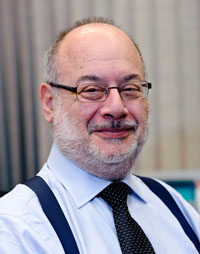 Avrum Gotlieb
Avrum Gotlieb
Prof. Gotlieb is the Senior Academic Advisor to the Dean (2011-2013), and Acting Vice-Dean, Graduate Affairs (2011-2013) in the Faculty of Medicine, University of Toronto. He obtained his BSc, MDCM and his Anatomic Pathology training at McGill University. He trained in the Department of Biology, University of California, San Diego, with S.J. Singer. Prof. Gotlieb joined the Department of Pathology at the University of Toronto in 1978. He is a cardiovascular pathologist at the University Health Network and a senior scientist at the Toronto General Research Institute. Prof. Gotlieb served as the founding Chair of the Department of Laboratory Medicine and Pathobiology (1997-2008), and as Interim Vice-Dean Research and International Relations (2009-2010) in the Faculty of Medicine, University of Toronto.
Prof. Gotlieb has received teaching awards from the hospital, the department, Faculty of Medicine, including two prestigious Aikins Awards and the Sustained Excellence in Graduate Teaching Award, as well as the Robbins Distringuished Educator Award from the American Society for Investigative Pathology (2011). He initiated an innovative and unique undergraduate arts and science specialist program in pathobiology that is in its 10th year and has seen many of its graduates go on to graduate and medical school. Prof Gotlieb authored the widely-disseminated informative career guide booklet, “The Road to Becoming a Biomedical Physician Scientist in Pathology and Laboratory Medicine,” sponsored by the American Society of Investigative Pathology and the Department of Laboratory Medicine & Pathobiology, University of Toronto, and in 2009 co-authored (with Dr. Tara Sander) a second career guide booklet for ASIP, “Journey to Success: Career Pathways for Biomedical Scientists in Pathology and Laboratory Medicine.”
Prof. Gotlieb’s research includes atherosclerosis and valvular heart disease. Studies on the cell biology of cardiac valves focus on the role of interstitial valvular cells in maintaining the structure and function of heart valves, and interstitial cell function related to repair and cell heterogeneity. In vitro studies on endothelial injury and repair directed at understanding how the cell cytoskeleton regulates cell migration, and how various growth factors and cytokines modulate both migration and proliferation related to repair. Earlier studies include the pathogenesis of intimal hyperplasia, a lesion that predisposes to fibrofatty plaque formation; and the role of growth factors, cytokines, and proteinases on intimal hyperplasia. He has published over 100 peer-reviewed papers, and 37 reviews and book chapters. He has edited three books, including the comprehensive textbook Cardiovascular Pathology, edited with colleagues Malcolm D. Silver of the University of Toronto, and Frederick J. Schoen of Harvard Medical School. He has been an invited visiting professor and keynote speaker at national and international universities and research institutes. He is co-editor of the journal Cardiovascular Pathology (2001-2011) and serves on the editorial board of several leading journals in pathology, the American Journal of Pathology and Laboratory Investigation.
Prof. Gotlieb has been an innovative leader in academic medicine creating national and international infrastructures to promote research and education. His focus has been on Pathology and Laboratory Medicine and Cardiovascular Pathology. He has provided guidance through carrying out external academic reviews, leading grant review panels and lecturing on the academic missions of Pathology and Laboratory Medicine. He is a past-president of the Canadian Society of Atherosclerosis, Thrombosis and Vascular Biology, the Society for Cardiovascular Pathology and the American Society for Investigative Pathology. He is past vice-president for science policy of the Federation of American Societies for Experimental Biology, Bethesda, MD. In 2006, Prof. Gotlieb was elected as a fellow of the Canadian Academy of Health Sciences, and will be awarded the Distinguished Achievement Award from the Society for Cardiovascular Pathology (2012).
2011 - Gaetano Thiene
 Gaetano Thiene
Gaetano Thiene
Gaetano Thiene M.D. is Professor of Pathology and Consultant of Cardiovascular Pathology, Department of Medical Diagnostic Sciences and Special Therapies at the University of Padua Medical School, Padua, Italy. He was Director of the Institute of Pathological Anatomy at the University of Padua from 1998-2006.
Following graduation from the Medical School at the University of Padua, Dr. Thiene trained as both a Cardiologist (University of Padua) and a Pathologist (University of Trieste). He is Honorary Fellow of the Royal College of Physicians in London, U.K., Foreign Member of the Serbian Academy of Science and Arts in Beograd, Serbia, Corresponding Member of the Galileian Academy in Padua and Vice-President of the Olympic Academy in Vicenza, Italy.
His research interests have been across the broad fields of Cardiovascular Medicine and Pathology, particularly directed to clinicopathologic studies and clinical translation of basic research. Dr Thiene first reported Arrhythmogenic Right Ventricular Cardiomyopathy (ARVC) as a major cause of sudden death in the young and in athletes (NEJM 1988) and has contributed to the elucidation of the genetic basis for ARVC. He is a principal architect of the Italian program in which all young individuals who participate in sports activities are screened for potential cardiovascular problems and in which all sudden unexpected deaths in the young are formally investigated by expert cardiovascular pathologists. This is the most successful such screening program in the world and it has led to major advances in understanding the causes of sudden death in the young. It resulted in a sharp decline (by 90%) of sudden death in the athletes of the Veneto Region, Italy, thanks to identification and disqualification of young people affected by cardiomyopathies. Dr. Thiene has been and continues to be a true visionary in this field.
Dr. Thiene has been the leader of the group in Padua which has worked at the interface between pathology and genetics in the cardiomyopathies and has identified several disease-causing mutations, correlating them with the clinical and pathological features of the disease. He has given important contributions to defining clinicopathologic correlations in heart valve disease and in the pathology of tissue valve substitutes, including the initial observation that calcification in human bioprostheses was initiated in cells. Dr. Thiene has made other contributions to congenital heart disease, molecular genetics and pathology of myocarditis, coronary artery disease, arrhythmias and conduction system disease, cardiac tumors, the use of the endomyocardial biopsy and cardiac transplantation.
Up to October 31st 2010, he has published nearly 700 reports of original investigations and reviews in Index leading journals of pathology and cardiovascular medicine, and additionally is co-author and/or co-editor of 15 monographs. His papers collected an overall Impact Factor of 2826 and 14083 quotations, with an Hirch index of 52 from 1996.
Dr. Thiene is Associate Editor of Cardiovascular Pathology and of the Journal of Heart Valve Disease, and serves on the Editorial Board and/or acts as reviewer of other prestigious journals in cardiology, medicine and pathology.
Moreover, Dr. Thiene has been a tireless champion of and participant in the Society for Cardiovascular Pathology (SCVP), of Cardiovascular Pathology as a subspecialty as well as of international cooperation. He has been a major driver of the Association for European CardioVascular Pathology (AECVP) and has motivated young people in Europe to enter the field of Cardiovascular Pathology, training several as a direct mentor.
More generally he has led the definition of educational and training requirements for Cardiovascular Pathology. He is Past-President of the SCVP (2003-05) and of the AECVP (2004-06). As immediate past SCVP Program Chair, he “revitalized” the Sunday Companion Society meetings in conjunction with the USCAP and he initiated a topical Saturday afternoon session of specific interest to Cardiovascular Pathologists.
2010 - Bruce McManus
2009 - L. Maximilian Buja
2008 - William D. Edwards
2007 - Renu Virmani
2006 - Frederick J. Schoen
2005 - Thomas N. James
2004 - Anton E. Becker
2003 - Keith A. Reimer
2002 - Ariela Pomerance
2001 - Hugh A. McAllister, Jr.
2000 - Giorgio Baroldi
1999 - Richard and Stella Van Praagh
1998 - Russell Ross
1997 - Michael J. Davies
1997 - Ramzi S. Cotran
1996 - Robert B. Jennings
1995 - Malcolm D. Silver
1994 - William C. Roberts
1993 - Jack L. Titus
1992 - Victor J. Ferrans
1991 - Margaret E. Billingham
1990 - Guido Majno
1989 - Earl P. Benditt
1988 - Donald B. Hackel
1987 - Robert W. Wissler
1987 - Maurice Lev
1987 - Reginald E.B. Hudson
1987 - Jesse E. Edwards
YOUNG INVESTIGATOR AWARD WINNER
SCVP celebrates the future leaders of our discipline.
Scoring criteria for our young investigator talks can be found here.
2024 - M. Kritselis
2023 - L. Lu
2022 - M. De Gaspari
2021 - P. Hurst
2020 - J. Westaby
2019 - P. Hanson
2018 - C. Glass
2017 - M. Bois
2016 - C. Leduc
2015 - G. Eng
2015 AWARD WINNING ABSTRACT
George Eng
Optimization of serum free light chain analysis for rapid and reliable subclassification of cardiac amyloidosis
George Eng, Marc K. Halushka, Daniel P. Judge, Marc J. Semigran, James R. Stone
Background: Accurate classification of cardiac amyloidosis, between transthyretin and light chain kappa or lambda, is paramount for optimal patient management. However, direct subtyping of amyloid deposits has significant drawbacks such as long turnaround time, high cost, and in some cases, the need to send the material to an outside reference laboratory. Potential differences in serum free light chain kappa/lambda ratios may provide a method to distinguish between different forms of cardiac amyloidosis. However, the standard upper and lower limits of normal for the assay are not optimized for cardiac amyloidosis classification. Therefore we investigated if optimization of the kappa/lambda serum free light ratios could allow for a novel method to accurately and rapidly subclassify cardiac amyloidosis.
Design: We investigated 78 cases of tissue proven cardiac amyloidosis (endomyocardial biopsy: n=65, ventricular septal myectomy: n=1, ventricular apical core: n=1, explanted heart: n=9, and autopsy heart: n=2) at two separate medical centers. All patients had serum free light chain analysis obtained prior to plasma cell neoplasm treatment in conjunction with routine classification of cardiac amyloidosis (mass spectrometry n=51, or immunofluorescence n=27). We then stratified the cases based on the ratio of kappa to lambda serum free light chains and correlated that value to their classification of cardiac amyloidosis.
Results: The serum free light chain kappa/lambda ratios were non-overlapping for the three types of amyloid identified: AL-lambda (0.01-0.41, n=29), ATTR (0.63-2.7, n=38), and AL-kappa (6.7-970, n=11). Using optimized cut-off values for the kappa to lambda serum free light chain ratio, we were able to accurately distinguish between the three common forms of ventricular cardiac amyloidosis within this cohort of patients. A kappa to lambda ratio value between 0.5 and 5.0 had 100% sensitivity and 100% specificity for distinguishing transthyretin from amyloid light-chain amyloidosis (n=78, 95% confidence interval: 89%-100% for both sensitivity and specificity). The capacity of this test to distinguish between forms of amyloidosis was equivalent for cases subtyped by either mass spectrometry or immunofluorescence.
Conclusions: Optimized ranges for serum light chain kappa/lambda ratio can provide extremely robust classification of cardiac amyloidosis. The assay is widely available, relatively inexpensive and can deliver accurate, rapid results. Cases of cardiac amyloidosis in which the kappa/lambda free light chain ratio falls close to these new cut-off values would likely benefit most from direct amyloid subtyping.
2014 - M. K. Mirza
2014 AWARD WINNING ABSTRACT
M. Kamran Mirza
C4d Immunoreactivity in Endomyocardial Biopsies after Heart Transplantation: A 10-Year Prospective Analysis
M Kamran Mirza, Savitri Fedson, Aliya N Husain.
Background: In the past decade C4d has emerged as a potential marker for AMR, however, literature regarding its use as a prognostic tool has been controversial. Currently, the ISHLT recommends C4d staining only in the first 90 days post-transplant. Our aim was to prospectively determine the prognostic value of C4d positivity in post-transplant endomyocardial biopsies (EMBs) by correlating with clinical cardiac dysfunction, cellular rejection, HLA status, death, and cardiac allograft vasculopathy (CAV) at autopsy.
Design: All 5862 endomyocardial surveillance biopsies from 241 consectuvie heart transplant recipients (transplant date 1/2002 – 12/2012) were stained prospectively for C4d from 2004. Immunohistochemical stains were performed on paraffin-embedded tissue using an anti-human C4d polyclonal antibody. Only strong diffuse endothelial staining was considered positive. All patients had at least 1 year of follow-up. Cardiac dysfunction at the time of positive biopsy was evaluated by hemodynamics and echocardiography. Cellular rejection was graded per ISHLT 1990 criteria.
Results: Positive C4d staining was present in 64 biopsies from 34 (14%) patients, 9 of whom (26%) had clinically significant cardiac dysfunction. 22/34 (65%) of C4d positive patients died. Autopsy was performed on 19 (8 C4d negative and 11 C4d positive patients) of the 58 deaths. 11/11 C4d positive patients had histologic evidence of CAV. Six of 8 C4d negative patients (75%) had no CAV, while 2 of 8 did. Time to first episode of C4d positivity was 406+383 (7-1302) days. Time to C4d positivity in 12 surviving patients was 224+191 days and in the 22 expired patients was 505 + 427 days.
Conclusions: In this study, C4d positive patients were younger (by a decade), had higher PRAs and higher mortality (65% vs. 17%) as compared to C4d negative patients. Later C4d positivity is not benign; warranting long-term surveillance. All 11 C4d positive autopsies revealed CAV as the cause of death. Even 1 episode of C4d positivity correlated with a poorer outcome. These findings show a positive association of C4d with CAV and death. Our results indicate a prognostic role for C4d in heart transplantation warranting routine detection (including long-term surveillance) of this marker in the pathologic evaluation of cardiac AMR.
2013 - S. Rizzo
2013 AWARD WINNING ABSTRACT
Stefania Rizzo
Intercalated Disc Ultrastructural Abnormalities Precede Histopathologic Changes in Desmoglein 2 Transgenic Mice and Are Associated with Conduction Slowing and Inducible Arrhythmias.
Stefania Rizzo, Elisabeth M Lodder, Arie O Verkerk, Rianne Wolswinkel, Leander Beekman, Kalliopi Pilichou, Cristina Basso, Carol A Remme, Gaetano Thiene and Connie R Bezzina
Background: We sought to evaluate the pathological substrate of electrical instability in the pre- phenotypic stage of arrhythmogenic cardiomyopathy (AC), before myocardial cell death and fibro- fatty replacement onset.
Design: We studied transgenic mice carrying mutation of desmoglein2 (dsg2) in the adhesive extracellular domain (Tg-NS). Gross, histological and ultrastructural analyses were used in the pre- phenotypic stage of the diseases, i.e., between 2 and 6 weeks. The structure and molecular composition of the ID was assessed by electron microscopy (EM) and by immunofluorescence. Mice with cardiac over expression of wild-type dsg2 (Tg-WT) and wild-type mice served as controls. Surface ECGs, electrical epicardial mapping and patch-clamp experiments were performed to determine ventricular conduction and arrhythmia susceptibility.
Results: At gross and histologic examination, Tg-NS hearts appeared normal, with no evidence of replacement-type fibrosis. Immunofluorescence uncovered no differences in the level and localization of junctional proteins between Tg-NS/L mice and controls. Ultrastructural examination of the myocardium ruled out cardiomyopathic changes, including cell necrosis, focal myofibrillar lysis, dilated sarcoplasmatic reticulum and T-tubules, and mitochondrial clustering at this age. Widening of the intercellular spaces at the level of desmosomes/adherens junctions was seen in otherwise morphologically normal cardiomyocytes in 25% of TgNS at 2 weeks and in 100% at 6 weeks and the percentage of widened cellular junctions increased with age (from about 10% at an age of 2 weeks to 60% at 6 weeks). Morphometric analysis showed that the intercellular space was significantly widened in Tg-NS/L mice (149 +/- 80 nm) compared with controls (32 3.5nm), p<0.05. None of the control mice (Tg-WT, WT) displayed any intercellular space widening. QRS- prolongation and inducible ventricular arrhythmias were observed in mutant mice. A reduced action potential (AP) upstroke velocity due to a lower Na(+) current density was also observed at this stage of the disease
Conclusions: Dsg-2 mutant mice display ultrastructural evidence of desmosomes /adherens junctions widening, before development of cardiomyopathic changes. This coincided with conduction slowing and inducible ventricular arrhythmias thus emphasizing the importance of ID integrity for proper electrical conduction.
2012 - S. Hynes
2011 - X. Zhang
2011 AWARD WINNING ABSTRACT
Xuchen Zhang
Oxidative Stress and ERK1/2 MAP Kinase Mediate Cardiomyocyte Injury in Transthyretin Cardiac Amyloidosis.
Xuchen Zhang, Qiang Xie, Duanjun Tan, Patty J Lee, Felicitas L Lacbawan, Jenny Libian. State University of New York, Downstate Medical Center, Brooklyn; Yale University School of Medicine, New Haven, CT
Background: Transthyretin (TTR) is associated with two forms of cardiac amyloidosis: familial (mutant TTR) and systemic senile amyloidosis (wildtype TTR). Approximately 4% of African Americans are heterozygous for V122I variant TTR, a mutation associated with familial amyloidotic cardiomyopathy. The mechanisms of TTR-induced cardiac injury remain elusive. Markers of oxidative stress have been associated with TTR amyloid deposits in peripheral nerve and we previously reported that oxidative stress and ERK1/2 activation mediate cell death in lung epithelium. We investigated the potential role of oxidative stress and ERK1/2 activation in mediating TTR-induced cardiomyocyte injury.
Design: Cases of TTR cardiac amyloidosis and age-matched controls were identified from 2007-2010 autopsy records. TUNEL and 8-OH-dG staining was performed on formalin-fixed paraffin-embedded sections from left ventricle. The TTR gene was sequenced using genomic DNA extracted from the paraffin blocks. Cultured rat cardiomyocytes were exposed to TTR fibrils formed by incubating wildtype TTR under acidic conditions. Apoptosis was assessed by TUNEL staining and Annexin V flow cytometry. Oxidative stress was examined by Western blot for heme oxygenase-1 (HO-1), reactive oxygen species (ROS) production, and 8-OH-dG staining. ERK1/2 activation was measured by Western blot of phospho-ERK1/2.
Results: Four cases of TTR cardiac amyloidosis (average age 82.8 years; range 80 to 87 years) were identified. All patients had presented with chronic heart failure and arrhythmia. TTR gene sequencing identified mutant TTR (V122I) in 3 cases and wildtype TTR in 1 case of cardiac amyloidosis. Positive staining of TUNEL and 8-OH-dG was more prominent in cases of cardiac amyloidosis than in control heart tissue. Rat cardiomyocytes treated with TTR fibrils showed more ROS production, HO-1 expression, phospho-ERK1/2, and apoptosis than untreated cardiomyocytes. Inhibition of ERK1/2 activation by PD98059 or ROS production by diphenylene iodonium ameliorated TTR fibril-induced oxidative injury and apoptosis.
Conclusions: Apoptosis and oxidative injury are increased in hearts of patients with cardiac amyloidosis compared with age-matched controls. Oxidative stress, ERK1/2 activation, and apoptosis are involved in TTR-induced injury of cultured rat cardiomyocytes. Inhibition of oxidative stress and ERK1/2 activation may provide a potential mechanism for prevention and treatment of cardiac injury associated with TTR cardiac amyloidosis.
2010 - V. Nair
2009 - H. Zhong
2008 - E. Carturan
2006 - H. Sattar
2004 - D. V. Miller
2003 - M. A. Laflamme
2001 - C. Basso
2001 - B. Thurberg
1999 - J. Ford
1998 - B. Sampson
1996 - C. Tan
1994 - C. Phillips
1993 - B. Fyfe
1993 - A. Joshi
1990 - G. Leclerc
1989 - K. Kottke-Marchant
MARGARET BILLINGHAM AWARD WINNERS
SCVP celebrates the top publications in Cardiovascular Pathology.
In 2021, the SCVP began awarding yearly recognition for the top article and top review paper in Cardiovascular Pathology, our journal. The award is named after the legendary cardiovascular pathologist, Margaret Billingham, whose career included the publication of many seminal studies.
2023 - Top Article The spectrum of macrophage-predominant inflammatory myocardial disease presenting as fulminant heart failure
2023 - Top Review Myocardial fibrosis: morphologic patterns and role of imaging in diagnosis and prognostication
2022 - Top Article COVID-19 myocarditis: quantitative analysis of the inflammatory infiltrate and a proposed mechanism
2022 - Top Review Current state of vaccine development and targeted therapies for COVID-19: impact of basic science discoveries
2021 - Top Article Myocarditis: something old and something new
2021 - Top Review The emerging spectrum of cardiopulmonary pathology of the coronavirus disease 2019 (COVID-19): Report of 3 autopsies from Houston, Texas, and review of autopsy findings from other United States cities
2020 - Top Article Thrombus on the inflow cannula of the HeartWare LVAD: an update
2020 - Top Review Lysosomal storage disorders affecting the heart: a review
HONORS FOR SCVP MEMBERS
The Society for Cardiovascular Pathology is proud of the honors our members have receive]d through their contributions to pathology and education.
Dr. Alison Krywanczyk
A 2022 top five winner of the ASCP 40 under Forty honor.
Dr. Yasmeen Butt
Dr. Peter Anderson
Dr. Melanie Bois
Dr. Barbara Sampson
Dr. Gayle Winters
Dr. Richard N. Mitchell
Dr. Peter Anderson
Dr. Peter Anderson
2011 Association of Pathology Chairs Michele Raible Distinguished Teaching Award in Undergraduate Medical Education
Dr. Avrum Gotlieb
2011 ASIP Robbins Distinguished Educator Award
Dr. L. Maximilian Buja
2009 Executive director of the Houston Academy of Medicine – Texas Medical Center Library
Know of an SCVP member who has received a big honor? Let us know.





